 USA (1916-46) R-1 to R-27, Coastal defence submersibles
USA (1916-46) R-1 to R-27, Coastal defence submersiblesWW1 US submarines:
USS Holland | A class | B class | C class | D class | E class | F class | G class | H class | K class | L class | M class | N class | O class | R class | S class | T class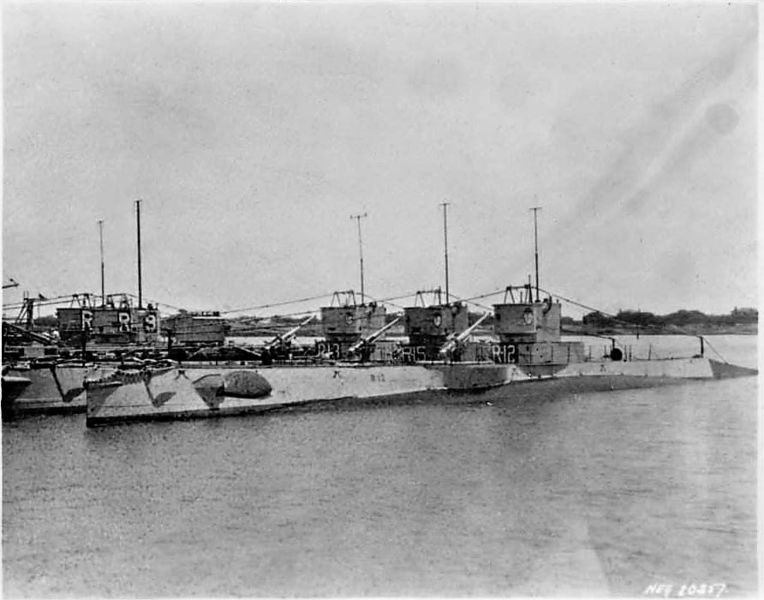
After the O class we saw last November 2023, here is one of the two last wartime mass-produced sub-classes built by the United States for the Navy, the R class. Like the S class (65 ordered, 51 completed), some of them missed WWI, but most of them saw action in WW2 nevertheless, notably as training boats to shape the new generation of Gato/Tench/Balao’s crews. They were an interesting development of previous medium types at nearly 700t submerged non-housing 3-in/50 deck gun, a lengthened hull for more torpedoes, and designed to reach 200ft. They were built by Fore River (master yard), Union Iron works, and Lake, the latter boats being the ones axed under Washington treaty limitations in 1930. The other 20 saw all service in WW2 with various fates, notably three under British service by lend-lease, HMS P514 rammed and sunk by error in 1942 by HMS Georgian, R12 torpedoed in the off Key West in torpedo practice, and R8 was scuttled in 1936. The others were stricken in 1946. #ww2 #usnavy #submarine #submersible #unitedstatesnavy #worldwartwo #secondworldwar
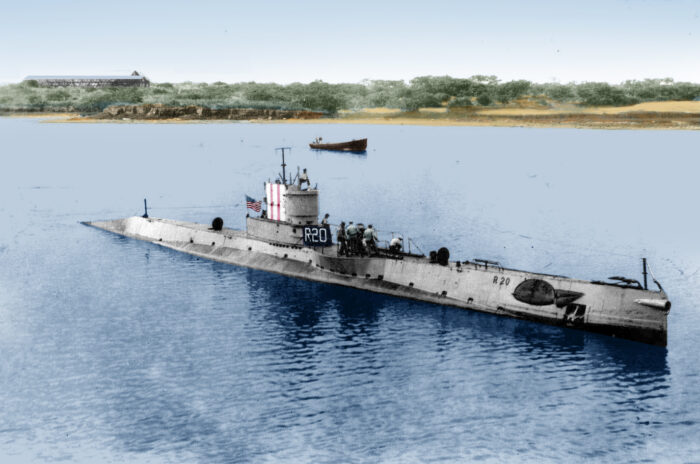
USS R-20 (SS-97) colorized by the author
To a wartime standard

The first wartime US design was also among the ones that served the longest for this generation. They were the first and last to see action both in WWI (albeit not all and in the last months or days) and WW2, although not deployed frontline. The following 27 R class were a near-repeat and also took part in WW2, and more so the 50 S-class from various yards. They were more active, and paid a heavy price, 10 being lost in action. Four were also transferred to the RN, one to Poland, but this will be the object of next post.
Prewar US submarine development: From USS Holland to the O class
The interest of the US Navy for submarines was variable. Yes the country was a pioneer, with the Independence’s Bushnell to the civil war HL Hunley, but the long eclipse of the “old navy” showed submersibles relegated to the whims and ideas of various engineers and inventors. At least until circumstance made, two of these stands out: Simon Lake (of future Lake Boats shipyard) and John Holland (of future Electric boats shipyards). The latter was an interesting case, an Irish engineer looking for ways to help his fellow insurgents against Britain. In the late 1890s their experiments were seen still with interest but reserve, even after the Spanish-American war under the growing Mahanian thinking. However, they were seen as more modern and useful to take the succession of US WWI torpedo boats, and defend the shores against an enemy blockade at a time the USN “new Navy” was just getting started and still with a small Atlantic squadron. Both Lake and Holland’s models were officially tested, USS Holland being chosen as the first USN service submarines, followed by series from A to N with incremental improvements and contract awarded to either Electric Boats or Lake TB.
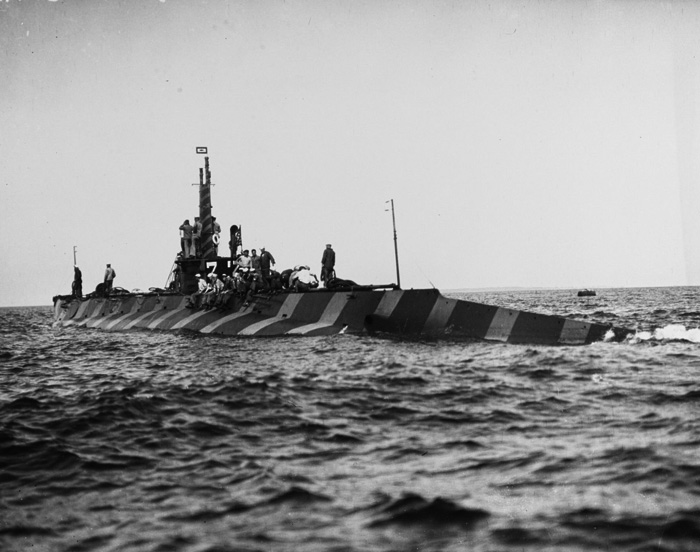
USS K2 in her quirky camouflage in 1918
Best prewar design were the H class launched in 1913 which generated “repeats” at Puget Sound but the K and L classes failed their trials and had engine problems, the latter introducing a deck gun, and partially retractable, being launched in 1915-16. The next O class, will try to improve on engines, and they did. Launched in 1917-18 they all saw limited service in WWI, being completed in 1918, some were scrapped in 1930 others became training boats in WW2. O 12 was resold to civilian service, was completely transformed to become Nautilus (the first), used for Polar navigation in 1931.
Design of the class
Design Development
The O class were seen as a successful class, albeit lacking deep diving capabilities and with a problematic gun deployments. Some captains also complained of their limited torpedo load, just eight. From there, the R class was developed as a further improvement on the O class in all criticized directions. There was no “P class”. They diverged not only from the O class in size, but also between Yards. Electric Boat Yard’s submarines were subcontracted to Bethlehem Quincy and Bethlehem San Francisco. They kept the essentials of the O-class, being single-hull boats structurally similar to the preceding O-class, but larger both in lenght and beam, draight as well, and therefore with had to be fitted with a more powerful machinery to maintain ther required speed of 14 knots. Unfortunately this was not the case (see later).
The Electric Boats had no longer the traditional rotating bow caps acting as the muzzle doors for the torpedo tubes and swapped for individual muzzle doors. For the first time also in U.S. submarines, 21 inches (533 mm) torpedo tubes were fitted instead of 18-inches, quite an increase in performances. This tube diameter would be rapidly an international standard. This alone ensured they stayed active for much longer in the USN. standard worldwide. Also armament was reinforced by a more powerful and non-retractable 3-inch (76 mm)/50 caliber deck gun, instead of the O class’s retractable 3-inch/23 caliber. Both made these R class much more potent than any previous US submarine type, and a solid basis on which to develop the S-class afterwards.
⚙ R class specs, Electric Boat |
|
| Displacement | 574 long tons (583 t) surfaced, 685 long tons (696 t) submerged |
| Dimensions | 186 ft 3 in x 18 ft x 14 ft 5 in (56.77 m x 5.49 x 4.39 m) |
| Propulsion | 2× 600 hp (447 kW) NELSECO 6-EB-14 diesels, 2× 467 hp (348 kW) Electro Dynamic Co. EM, 2× 60-cell batt. |
| Speed | 12.5 knots (23.2 km/h; 14.4 mph) surfaced, 9.3 knots (17.2 km/h; 10.7 mph) submerged |
| Range surfaced/sub. | 4,700 nmi at 6.5 kn sufaced |
| Armament | 4× 21 in TTs (8 torpedoes), 3 in/50 deck gun |
| Test Depth | 200 ft (61 m) |
| Crew | 29 |
Hull and general design
Being an extrapolation of the O, and thus of the L class, they kept the same general outlook with their hull shaped like a splindle, narrow outer hull above, and narrow deck, apart for the gun platform. There was another platform created by wolkways on both sides of the conning tower, with hanbarrs all along to transition from the fore to the aft deks, which was quite short and ended with a shap back straight down under. The helmsman post was built over the upprt part of the CT, placed on a base, and if it was originally protected by canvas, now received a rigid cover with many reinforcements and breakwater rings. The periscopes mountings were aft.
The R class were heavier and larger than the O class, with the displacement up to 680t submerged, versus 630t for the O class. A few feets longer and inches larger thay had the same hanging protection cable strapped between the prow’s tripod and aft’s to go under heavy nets. The deck gun was much larger, heavier, but also more capable, and needed to be fixed permanently on a platform built above the deck, sponsoned to allow the crew to operate on a full traverse. This was a first, shared by the T class (fleet submarines) and was repeated on the S class. No longer a 3-in/28 (76mm), considered weak, it was replaced by a 50 caliber on the R class, and even became a 4-inches/50 (102 instead of 76 mm) on the next S class. The move towards the 5-in deck gun was done after obtaining some U-Boats in war reparation and interwar submarines.
Powerplant
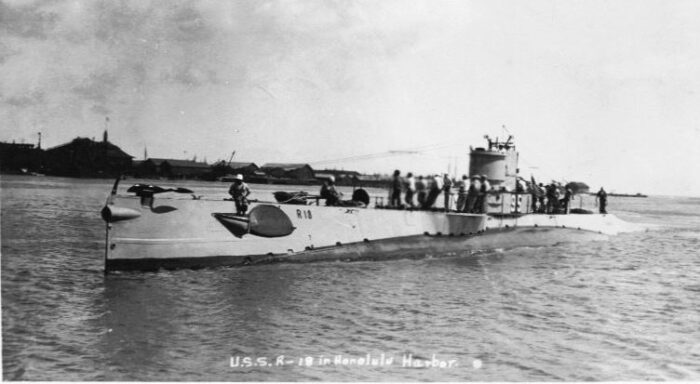
USS R-18, a Lake boat underway.
Here the split between Lake and Electric Boat designs was apparent. Each yard came with its own suppliers for the diesels and electric motors. This was accepted by the Navy as being able to compare this larger powerplant, until then one of the largest installed, exception of the mediocre TT (Schley) class fleet subs.
Electric Boat design:
Two shafts with two 600 hp (447 kW) or 1200 hp total NELSECO 6-EB-14 diesel engines for surface running,
Two 467 hp (348 kW) or 934 hp Electro Dynamic Co. electric motors
Two 60-cell batteries with a new type of more powerful units.
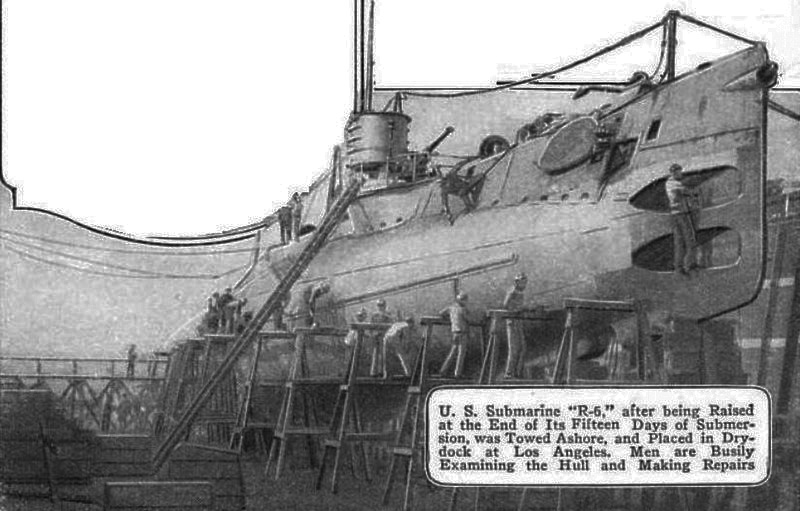
USS R-6 (Electric Boat, Fore River) after her salvage.
Lake Torpedo Boat Co. design:
Two 500 hp (373 kW) Busch-Sulzer diesel engines, 1000 hp for surface running
Two 400 hp (298 kW) Diehl electric motors, 800 hp for underwater travel
A 120-cell batteries group, smaller old syle units.
This different in output, with the Electric Boats being larger caused a discrepancy in speed and range:
The Electric Boat design proved even slower than the previous O class at 12.5 knots (23.2 km/h; 14.4 mph) surfaced and 9.3 knots (17.2 km/h; 10.7 mph) submerged
The Lake Torpedo Boat Co. were capable of 14 knots (26 km/h; 16 mph) surfaced (actually the contracted speed) and 11.4 knots (21.1 km/h; 13.1 mph) submerged, overall making the fastest US subs so far at least submerged. For the next S class, Electric Boats was pressed to review its copy.
Whatever the types, the single engine room contained both diesels with a small walkway betwene them for maintenance, clutched to a shaft passing through the bulkhead and into the motor room and after torpedo room, driving a motor which doubled as a generator. Each motor was clutched to its own propellor shaft, and guaranteed flexibility. Underway, the diesels drove the propellor through the motor which armature was free wheel until contact was applied and could produce a current charging the battery and provide power for other uses. When propulsion and lighting power equaled the battery it was called a “zero float” allowing to keep the charge.
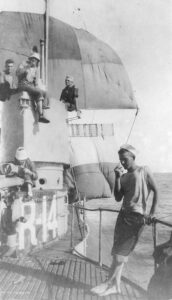 Seen here are the jury-rigged sails used to bring R-14 back to port in 1921; the mainsail rigged from the radio mast is the top sail in the photograph, and the mizzen made of eight blankets also is visible. R-14’s acting commanding officer, Lieutenant Alexander Dean Douglas, USN, is at top left, without a hat.(Source: US Naval Historical Center). Another R class sub also from the same division 9 had a similar issue, batteries flooded, and also managed to sail back to Hawaii. Both captains and crews were commended by Chester Nimitz for their resourcefulness. This also made it into the press and impressed F.D. Roosevelt which in 1941 took advice for the Doolittle raid by a submariner officer.
Seen here are the jury-rigged sails used to bring R-14 back to port in 1921; the mainsail rigged from the radio mast is the top sail in the photograph, and the mizzen made of eight blankets also is visible. R-14’s acting commanding officer, Lieutenant Alexander Dean Douglas, USN, is at top left, without a hat.(Source: US Naval Historical Center). Another R class sub also from the same division 9 had a similar issue, batteries flooded, and also managed to sail back to Hawaii. Both captains and crews were commended by Chester Nimitz for their resourcefulness. This also made it into the press and impressed F.D. Roosevelt which in 1941 took advice for the Doolittle raid by a submariner officer.
Diving required to unclutch the diesels from the shaft so to operate on batteries and motors alone. This combo could be used also to back down. In port, the motor was declutched from the shaft and solely used as generator to charge the battery. Over the engine clutch was mounted the “throne”, so in view of all and vibrating. Users were greeted by a fine oil vapor as well.
There was no air induction and large pipe carried air into the boat and for the engines. When the diesels were running all hatches and doors from the bridge were left open. In case of heavy weather or a rogue wave this could be catastrophic. These were cases of instant flooding and batteries put into jeopardy. Some boats were found dead in the water for some time because of this, but they generally survived and could sail home under their own power.
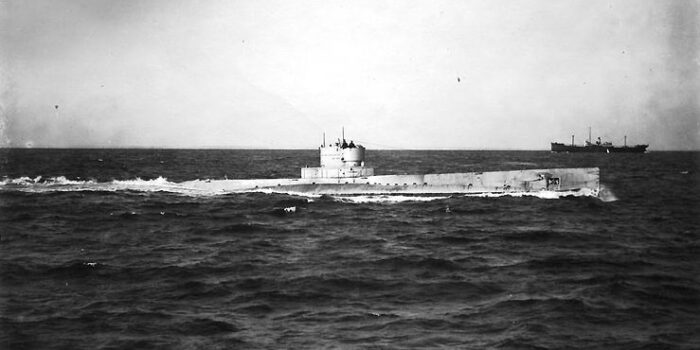
The same R-14 which lost all power in 1921. While under sail at 2 knots, enough traction was impulsed to the propellers in a free windmill fashion to reload the batteries enough to complete the trip to Hawaii by battery power.
Armament
Deck Gun: 3-in/40
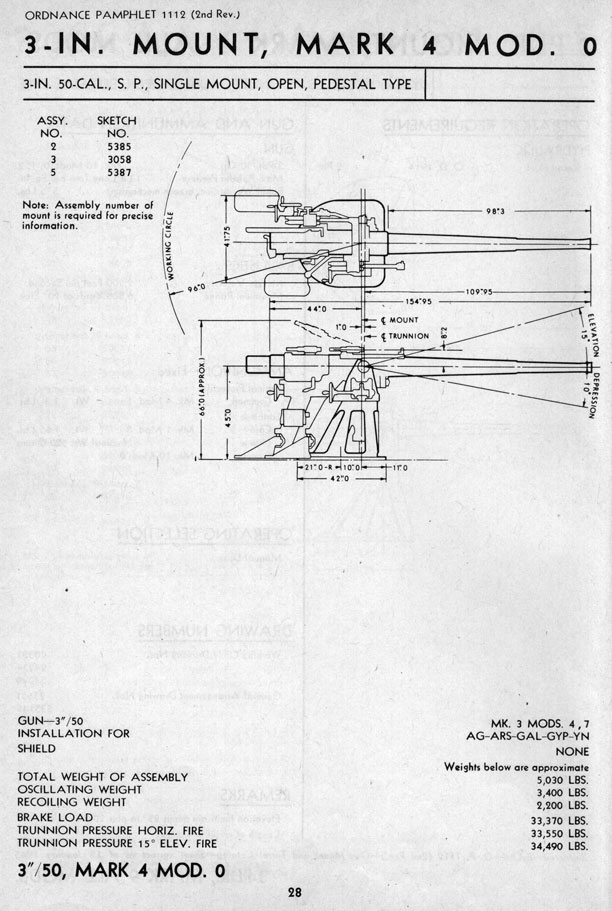
3-in/50 Mark 4 specs and sheet, src navweaps.
The O class already had a 3 inch (76 mm)/23 caliber gun made non-retractable in later batches to simplify design and spare extra weight. This was repeated on the R class, with a new 50 caliber model that became pretty standard. It was discovered that the drag observed was less than expected. The 3-in/50 was a grand family started in 1898 when designed, exact caliebr 7.62 cm of the Marks 2, 3, 5, 6 and 8. It seems on the Lake and Electric Boat models, they sported the same Mark 6.
Weight, by analogy to the Mark 5 c2,300 lbs. (1,034 kg) with breech with a bore lenght of 150.3 in (3.816 m)
They had the same Welin breech block and were capable of 15-20 rounds per minute.
They fired a 24 lbs. (10.9 kg) or AP Mark 29 Mod 1/2 weighting 13.1 lbs. (5.9 kg) with an 1.27 lbs. (0.58 kg) Black Powder and TNT charge
The AP carried a 0.3 lbs. (0.14 kg) Explosive warhead, being 12.16 in (30.9 cm) long but the common HE shell was 12.13 in (30.8 cm).
The Propellant Charge was augmented from 2.7 lbs. (1.2 kg) to 3.7 lbs. (1.68 kg) SPD or SPDN in WW2.
Muzzle Velocity was 2,700 fps (823 mps) with an approximate Barrel Life of 4,300 rounds.
At 4.3 degrees it was capable of 4,500 yards (4,150 m) range with the HE round.

Torpedo Tubes
The R-class came out with new 53 cm tubes and albeit the spaced was a bit larger only eight torpedoes, one reload for each tube, can be carried. The torpedo room was internally painted in white and fairly roomy, to six or eight bunks being setup, and kept brightly white with deck covering in canvass painted a bright green shellac. As for the new, larger torpedo tubes they had often their own barrels white. The tube doors were in brass and well polished. The four torpedoes were stored in racks alongside the bulkhead two on either sides, with two traveling chainfalls running down overhead. The torpedo crew had to find its center of balance with the chainfall and line it up with the tube, then insert it up to the hoisting strap which could be removed and adapter inserted in the tail. It was hooking a block and tackle into it, pulling the rest of the torpedo all the way into the tube.
There was no Torpedo Data calculations done mechanically, and the gyro angle was ordered from the control room, after which a spindle was insterted to set up the angle ordered, then withdrawn before firing. The tube shutters and outer doors were opened manually with forward Trim being used to flood the tube prior opening the outer shutter doors. The same same tank was used to drain the tube after being been fired and outer doors confirmed closed. The torpedo room could be even possibly used as an escape chamber via the tubes. These boats allo has a was a mushroom anchor under the keel, operating from inside the room and called the “submerged anchor”. Its casing was flooded to almost negative buoyancy, being being dropped and leaks were tested.
As for the torpedoes, since 1915 there was already a model used by flush deck destroyers, the Bliss-Leavitt Mark 8. It was decided to derived from it a submarine-capable model, which had some perks. Two models could be carried at first:
Bliss-Leavitt 21″ Mark 9 Mod 1B: Entering service in 1916, Wet-heater for 5,500 yards (5,030 m)/34.5 knots with a 395 lbs. (179 kg) Torpex warhead.
The Mod 1 was used by Battleship and had a different warhead and specs. The Mark 9 was specifically used by the Used by “R” and “S” class until WW2, and considerable stocks were developed.
In alternative they could use the 21″ (53.3 cm) Mark 10, the last designed by Bliss at the manufactured by the Naval Torpedo Station at Newport. Entering service in 1818 they will be detailed on the next article on the S class boats.
The Lake boats:

R-21 in fitting out on the West Coast. The Lake boats were considered mediocre at best. Notably their engine choices seems good on paper and gave them the best top speed of the class, but they developed all many engine troubles that crippled their short operaitonal life of a few years, before inactivation and scrapping in 1930.
R-21 to R-27 were slightly smaller and faster than the Electric Boat ones. They were designed and built when Simon Lake gave up on his patented zero-angle (“even-keel”) diving method using midships mounted diving planes. Instead they received the now standard Electric Boat angled diving method provided by bow and stern mounted diving planes. The Lake boats also differed in having a flat shovel stern, with ventrally mounted rudder but the diving planes and propellers were the same. Some sources gave contradictory claims as the torpedo tubes actually mounted on Lake boats, Gardiner and Friedman stating either 18 inch (450 mm) torpedo tubes or the new 21-inch tubes of the Electric Boat submarines.
They were however in anyway provided with the same 3-inch/50 caliber deck gun. R-22 (SS-99) and perhaps anoother tested a reworked bow for an expanded buoyancy making her humped. This also improved surface while surfaced underway, and unlike Electric Boats they were scrapped in 1930, not because of obvious technical inferiority but due to the US Navy complying with the London Naval Treaty albeit some poorly regarded design features and eventual bankrupcy in 1924 also did their part. A choice just had to be made. In any cased Electric Boat was solidly entrenched as the go-to submarine designer in the USN for many years to come. Its facility in Groton was also responsible for USS Nautilus and countless important designs that John Holland was no longer around to see.
⚙ R class specs, Lake Boat |
|
| Displacement | 497 long tons (505 t) surfaced 652 long tons (662 t) submerged |
| Dimensions | 175 ft x 16 ft 7 in x 13 ft 11 in (53 x 5.05 x 4.24 m) |
| Propulsion | 2× 500 hp (373 kW) Busch-Sulzer diesels, 2× 400 hp (298 kW) Diehl EM, 120-cell batt. |
| Speed | 14 knots (26 km/h; 16 mph) surfaced, 11.4 knots (21.1 km/h; 13.1 mph) submerged |
| Range surfaced/sub. | 4,700 nmi at 6.5 knots sufaced |
| Armament | 4× 21 inches* TTs (8 torpedoes), 3 in/50 deck gun |
| Test Depth | 200 ft (61 m) |
| Crew | 33 |
*21 inches in Conways, other sources 18 inches
Construction and Service
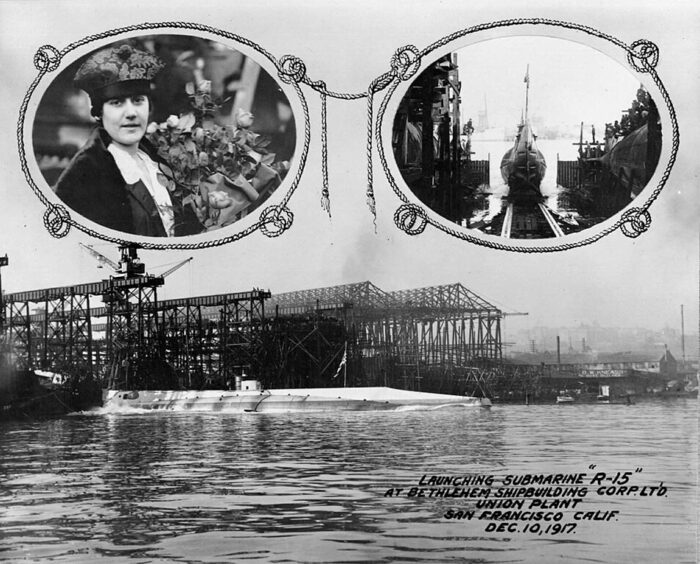
Launch of USS R-15 in October 1917, the first of the R-class was from Union Iron Works, commissioned in July 1918.
Design and construction of these 27 boats, more than the 16 O-class, was split between Fore River Yard (Electric Boat Company) and the Lake Torpedo Boat Company, with Union Iron Works yard entering the fray. The new design were built to the same general military operational specifications as the O class but differed considerably in design and detail specifics. For Union Iron Works (UIW) this was not their first submarines though. They already built three of the K class back in 1914, two H class in 1913, and back to the USS A4 back in 1902.
Fore River delivered the bulk, from R1 to R14, but Union Iron Works were the first to deliver their boats (R15-R20), launched for three of them, symbolically, in December 1917. Two in January 1918 and on in August. Lake delivered the R-21 to R-27. As said above, they were the only ones not to be in service in WW2, except R-8 scuttled in 1936.
Most of Electric Boat group were assigned to the Pacific, HP San Diego and Hawaii. In 1921 R-14 (SS-91), was stranded at sea in the Pacific when running out of fuel when performing herself a search and rescue operation. Thanks to makeshift sails she managed to cross 140 miles to Hilo, Hawaii, feasted when they returned as she was reported msising and overdue. The boats based in Hawaii returned to San Diego on January 18, 1931, then sailed to the east coast to be decommissioned in reserve at Philadelphia Navy Yard in 1931. They were recommissioned in 1940, after some preparations for activation, and a crew of reservists, they multiplied patrols in the Caribbean when not used as sonar targets at Key West ASW center in Florida. Some were based at New London in Connecticut and Bermuda for mid-Atlantic patrols.
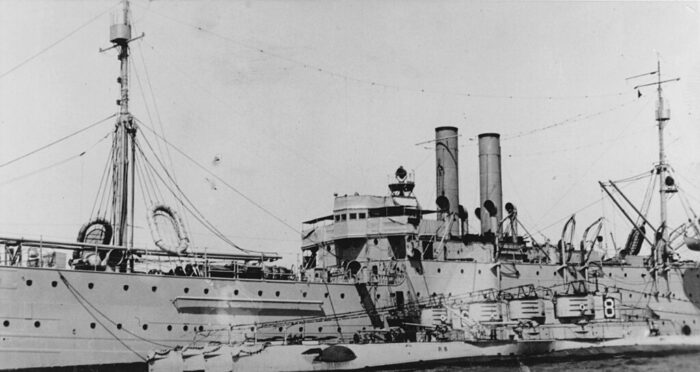
Four R-class subs berthed alongside USS Camden tender (AS-6) in San Diego 1923.
At least two R-boats susprised and torpedoed (but missed) surfaced German U-boats caught at night during these Bermuda patrols. R-3, R-17, and R-19 were transferred to the Royal Navy under lend-lease (many more S-types also were transferred). They became HMS P.511, HMS P.512, and HMS P.514 in 1941-1942. P.514 was lost on 21 June 1942 in a collision with Canadian minesweeper HMCS Georgian. As its captain could not find her type in his booklet and due to her conning tower’s resemblance to the Type VII she was mistaken for such as rammed.
USS R-12 (SS-89) was lost on 12 June 1943 while underway off Key West and it remained a mistery for many years. In 2010 she was located again and divers inspected her hull, establishing a possible cause coming from a massive failure in the forward battery compartment. It’s possible than a sudden rush of water caused an explosion string enough to displace rivets (yes the pressure hull was riveted) and caused an unstoppable flooding.
After the S-4 (SS-109) disaster in 1927, all Electric Boat submarines received recommended safety modifications, notably with a motor room escape hatch added, being the after most compartment. There was a tapered after casing shaped as a step. They also received salvage air connections and mating surfaces around topside hatches. It was tailored to receive the McCann Rescue Chamber and rescue extra trapped crewmen. There was also the old same procedure of escape via the forward torpedo tubes, provided it was not too deep, and that breething apparatus were available. In 1930 they were still in their infancy.
One R-class submarine was immortalized in the 1943 movie “Crash Dive” at the New London submarine base.
Electric Boat also exported the type to Peru, named R-1 to R-4 and built postwar using materials assembled from cancelled S-class submarines mated with engines and elements from R-class boats. They were ultimately refitted in 1935–36 and 1955–56 in the US, renamed Islay, Casma, Pacocha, and Arica in 1957, oriignally built at the new Thames River Yard in Connecticut (Groton) and when discarded in 1960 were the oldest of their type ever to be retired. See the Peruvian Navy for more.
In December 2020, the remains of R-8 were discovered off the coast of Ocean City in Maryland when she was sank on 1936, being a target boat for bombers, instead of just joining the scrapyard.
Career of the R class
 R1 (1918)
R1 (1918)
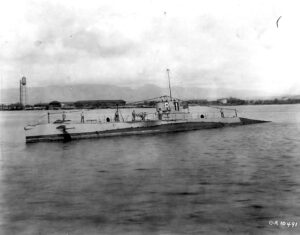 USS R-1 (SS-78) was from Bethlehem Quincy Laid down on 16 October 1917 lauched on 24 August 1918 commissioned 16 December 1918. After shakedown in New England waters she joined SubDiv 9, Atlantic Fleet, New London, Connecticut. She departed on 4 December 1919 for Norfolk and start and winter exercises in the Gulf of Mexico and back on 18 May 1920, the 4 months of summer exercises with R-2 and R-3.
USS R-1 (SS-78) was from Bethlehem Quincy Laid down on 16 October 1917 lauched on 24 August 1918 commissioned 16 December 1918. After shakedown in New England waters she joined SubDiv 9, Atlantic Fleet, New London, Connecticut. She departed on 4 December 1919 for Norfolk and start and winter exercises in the Gulf of Mexico and back on 18 May 1920, the 4 months of summer exercises with R-2 and R-3.
On 13 September she entered Norfolk for overhaul.
She became SS-78 by July 1920 and was reassigned to the Pacific on 11 April 1921, arrived on 30 June in San Pedro, in time for fleet exercises off Central America from 5 February to 6 April 1923 and reassigned to Pearl Harbor on 16 July, staying here for eight years. She departed on 5 January 1931 for Philadelphia, arrived on 9 February and was decommissioned on 1 May. The reason was the London Treaty and tonnage limitations for submarine. Unlike the Lake boats, her and sisters were mothballed in long term reserve (which happened to be nine years).
Recomm. on 23 September 1940 at Groton she was overhauled, partly modenrized, and by mid-October she joined SubRon 3, Division 42 on 10 December, crossed Panama for Coco Solo and stayed there until June 1941, reassigned to SubDib 31 and arrived at New London in October for a refit, then assigned to SubRon 7. On 9 and 10 December she patrolled from New England to Bermuda, and was deployed to hunt freely for U-boats now unleashed against the American coast. They were based at Ordnance Island, Bermuda and were especially active in early 1942, Dönitz “happy times”.
In February R1 patrolled between Bermuda and Nantucket Island. While off 300 miles (480 km) northeast of Bermuda under Lieutenant James D. Grant she spotted an U-Boat (later identified as U-582) surfaced by night, recharging batteries as customary, and torpedoed her, reporting her first kill. But she missed.
R-1 continued patrols from Bermuda until back to New London on 20 July for upkeep, R&R and local ops, but by late September, she was back in Bermuda. Until November 1944 she rotated between Bermuda and New London and had her last overhaul in December and conversion to take part in advanced ASW tactics. She sailed on 26 February 1945 to New York City, then Florida for three weeks off Port Everglades and back to New London, and Casco Bay, Maine in April-May 1945, then back to base on 29 June, and on 7 July the Fleet Sonar School at Key West until decommissioned on 20 September 1945, stricken 10 November. While scheduled to be disposed of on 21 February 1946, she sank in 21 feet (6.4 m) of water until raised 3 days later and sold for scrap on 13 March.
 R2 (1918)
R2 (1918)
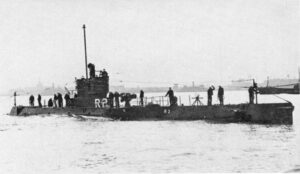 R2 (S) was laid down on 16 October 1917, launched 23 September 1918 and completed on 24 January 1919 with Lt. Cdr Charles Maynard “Savvy” Cooke, Jr. in command. After acceptance trials in Cape Cod Bay, assigned to SubDiv 9 Atlantic Fleet, HP New London. December 1919 Norfolk, winter division maneuvers, Gulf of Mexico. New London 28 May 1920, joined R-1, R-3 summer exercises New England. SS-79 17 July 1920, Norfolk 13 September overhaul.
R2 (S) was laid down on 16 October 1917, launched 23 September 1918 and completed on 24 January 1919 with Lt. Cdr Charles Maynard “Savvy” Cooke, Jr. in command. After acceptance trials in Cape Cod Bay, assigned to SubDiv 9 Atlantic Fleet, HP New London. December 1919 Norfolk, winter division maneuvers, Gulf of Mexico. New London 28 May 1920, joined R-1, R-3 summer exercises New England. SS-79 17 July 1920, Norfolk 13 September overhaul.
Pacific Fleet 14 April 1921, Panama, 30 June San Pedro, fleet exercises Central America 5 February-6 April 1923. Hawaii 16 July SubDiv 9, stayed eight years, endurance cruise to Midway July-August 1924. Left 12 December 1930 for Atlantic Fleet, New London, SubDiv 4, served ten years as TS, Submarine School and Yale Naval Reserve Officer Training Corps. SubDiv 12 1 June 1941, New London, Key West, HP. Fleet Sonar School, defensive patrols. 25 August 1942 mistook for U-Boote, she is fired at by USCGC Cartigan (WSC-120) off Key West. By the spring of 1945 she is sent to Philadelphia for inactivation, decommissioned on 10 May, stricken 2 June, sold 28 September 1945, resold October 1945, BU 1946.
 R3 (1919)
R3 (1919)
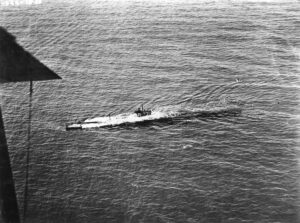 S-80 was Laid down on 11 December 1917, launched on 18 January 1919 and commissioned on 17 April 1919. After shakedown off Massachusetts she was sent to SubDiv 9 New London, sailed with the coaling ship USS Camden (4 December) for Norfolk, winter ex. Gulf of Mexico until 27 March 1920 then summer exercises, reclassed SS-80 July 1920; overhauled Norfolk 13 September.
S-80 was Laid down on 11 December 1917, launched on 18 January 1919 and commissioned on 17 April 1919. After shakedown off Massachusetts she was sent to SubDiv 9 New London, sailed with the coaling ship USS Camden (4 December) for Norfolk, winter ex. Gulf of Mexico until 27 March 1920 then summer exercises, reclassed SS-80 July 1920; overhauled Norfolk 13 September.
Transferred Pacific, San Pedro, two years then from July 1923 Pearl Harbor and reassigned 12 December 1930 Atlantic Fleet SubDiv 4 starting from 9 February 1931, HP New London. Submarine School TS, then May 1931 Washington, DC air purification tests, Naval Research Laboratory. 1932, sound and radio experiments, Deep Sea Diving School, Piney Point, Maryland. Reduced commission 26 April 1933, tests low-pressure valves Naval Research Laboratory. TS Annapolis from 2 June 1933. 22 February 1934 Guantanamo Bay, sound operations with Eagle 58, then Deep Sea Diving School. Decommissioned 10 August 1934 Philadelphia, recommissioned 19 August 1940 New London, SubDiv 42. Sailed 10 December for Coco Solo. Patrols and training until mid-1941, New London, transferred to RN after decommission 4 November 1941, stricken 7 November 1941, became HMS P.511 training sub until returned 20 December 1944. Scrapped in Scotland 1948.
 R4 (1918)
R4 (1918)
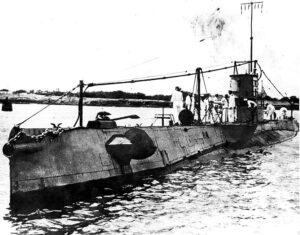 SS-81 was laid down on 16 October 1917, launched on 26 October 1918 and commissioned on 28 March 1919. Outfitted Boston Navy Yard, SubDiv 9 August 1919. Norfolk, for winter operations, Gulf of Mexico until 14 April 1920. New England in May, SS-81 in July, Norfolk 15 September for overhaul lasting until April 1921.
SS-81 was laid down on 16 October 1917, launched on 26 October 1918 and commissioned on 28 March 1919. Outfitted Boston Navy Yard, SubDiv 9 August 1919. Norfolk, for winter operations, Gulf of Mexico until 14 April 1920. New England in May, SS-81 in July, Norfolk 15 September for overhaul lasting until April 1921.
Pacific from 11 April 1921, San Pedro 30 June. Battle fleet exercises, Gulf of Fonseca (5 February-6 April 1923). Transferred 16 July to Hawaii, HP Pearl Harbour witth SubDiv 9, tender USS Canopus (AS-9) for eight years. 12 September 1925 R-4 rescued John Rodgers and crew, flight attempt from California to Hawaii.
Back to Atlantic 12 December 1930, HP New London. SubDiv 4 as TS for ten years, rotating duty New London Sub School/Yale Univ. NROTC. 1940-1941 was under command of Lieutenant Glynn R. Donaho (future vice admiral), departed 26 May 1941 for Key West, patrols with SubDiv 12. Was back at New London for R&R in July. Patrolled off Key West until March 1945 alt. with Sonar School. Stayed at Port Everglades 11 March to 15 April 1945, then Key West for inactivation. Escorted to Philadelphia by SC-1001 8 June, decommissioned 18th, stricken 11 July, sold 1946 for scrap.
 R5 (1918)
R5 (1918)
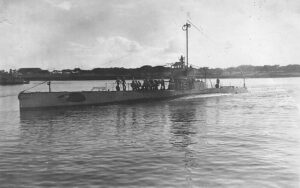 SS-82 laid down on 16 October 1917, launched on 24 November 1918 and commissioned on 15 April 1919. Outfitted Boston, departed 28 April 1919 for New London, SubDiv 9. Norfolk, winter exercises Gulf of Mexico, Newport 18 May, summer training, SS-82 on 17 July 1920, 13 September Norfolk overhaul. Sailed with her division to the Pacific, 30 June San Pedro and in January 1923 was used for the movie “The Eleventh Hour”. War games with battle fleet, Gulf of Fonseca until 6 April 1923. 16 July transferred to Pearl Harbor with Division. Endurance run to Midway July-August 1924. December in division exercises off Pearl Harbor, rammed R-16 in her aft battery room, both damaged and repaired.
SS-82 laid down on 16 October 1917, launched on 24 November 1918 and commissioned on 15 April 1919. Outfitted Boston, departed 28 April 1919 for New London, SubDiv 9. Norfolk, winter exercises Gulf of Mexico, Newport 18 May, summer training, SS-82 on 17 July 1920, 13 September Norfolk overhaul. Sailed with her division to the Pacific, 30 June San Pedro and in January 1923 was used for the movie “The Eleventh Hour”. War games with battle fleet, Gulf of Fonseca until 6 April 1923. 16 July transferred to Pearl Harbor with Division. Endurance run to Midway July-August 1924. December in division exercises off Pearl Harbor, rammed R-16 in her aft battery room, both damaged and repaired.
R-5 transferred Atlantic 12 December 1930, HP New London 9 February 1931, SubDiv 4 1 April, TS for Submarine School. 28 April sailed for decom. Philadelphia, 30 June 1932.
Recom. 19 August 1940, SUbDiv 42 New London 30 October. 10 December HP Coco Solo, Panama, patrol duty, back New London 31 October 1941. Overhaul and relieved R-1 on Bermuda-New England shipping lanes. Alternated with ASW training. Had twice contacts with U-boats and 10 February, fired torpedoes but missed one. From 1943 to 1945, rotated New London/Bermuda. Incativated in Portsmouth 6 September, decommissioned 14 th, stricken 11 October, sold 22 August 1946.
 R6 (1919)
R6 (1919)
SS-83 was laid down on 17 December 1917, launched on 1 March 1919 anc commissioned on 1st May 1919. Outfitted Boston, SubDiv 9 Atlantic Fleet HP New London from 16 September, tender USS Camden (AS-6) with five other R class. Swept away by gale, grounded on Black Rock, New London. Helped by two minesweepers, freed, repaired, returned to service. 4 December 1919 departed for Norfolk, winter exercises, Gulf of Mexico until 14 April 1920, back New London May 1920 for summer maneuvers, sailed September 1920 to Norfolk for overhaul.
Became SS-83 17 July 1920, Pacific Fleet April 1921, San Pedro. Had a malfunction in a torpedo tubes (lid not closing), sank in San Pedro 26 September 1921, refloated 13 October. From 26 February to 2 March 1923 used in filiming “The Eleventh Hour”. Transferred on 16 July 1923 to Hawaii, back Atlantic fleet 12 December 1930, February 1931 was inactivated in Philadelphia, decommissioned on 4 May 1931. Recommissioned New London 15 November 1940, SubDiv 42, sent to Coco Solo until 16 June 1941. Transferred to SubDiv 31, Saint Thomas, US Virgin Islands 22 June 1941, patrols until R&R on 8 October 1941. U-boat patrols between Nantucket and Bermuda in 1942: Submerged daily periscope patrols, surfaced night patrols on coastal traffic lanes. From 1943 to mid-1945 ASW training fordestroyers and destroyer escorts. 13 March 1943 while in torpedo exercises with USS Sapphire (PYc-2) off Block Island Sound, Rhode Island, mistook for an U-Boat by 4 U.S. Navy TBF-1 Avenger (Air Group 16), depth charged. Made a dive, took damage but no casulaties. Assisted by USS PC-826 and other boats from Montauk. Came back to port for repairs. Tested a new submarine snorkel between April and August 1945, originally created by the Dutch but the USN rejected the offer in 1940. She tested the US model off Fort Lauderdale in August 1945. Was decommissioned at Key West, 27 September, stricken 11 October, sold for BU March 1946.
 R7 (1919)
R7 (1919)
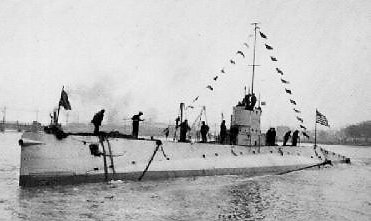 R-7 laid down 6 December 1917 Fore River, launched 5 April 1919, commissioned 12 June 1919, fitted out in Boston, HP New London SubDiv and in November training off Connecticut coast. December Norfolk, winter exercises, Gulf of Mexico. April 1920 Pensacola and New England by May. SS-84 in July. 13 September overhaul at the Norfolk until April 1921. Pacific Fleet, San Pedro, 30 June. 11 July 1923 HP Pearl Harbor. Fleet problems, patrols, rescue operations. 12 December 1930 sailed back east coast, Philadelphia 9 February 1931, decommissioned 2 May, Reserve Fleet. Recom. 22 July 1940, to New London activation 14 March 1941. By May patrolled off the Virgin Islands/Panama. 8 October New London, verhaul until November. ASW patrols on shipping lanes Bermuda-northeastern coast. May 1942, sighted U-boat, launched four torpedoes but missed and lost contact. From spring of 1943 to Sept. 1945 she trained destroyers and destroyer escorts in ASW tactics. Portsmouth 6 September, decommissioned 14th, stricken 11 October. September 1946 sold for scrap.
R-7 laid down 6 December 1917 Fore River, launched 5 April 1919, commissioned 12 June 1919, fitted out in Boston, HP New London SubDiv and in November training off Connecticut coast. December Norfolk, winter exercises, Gulf of Mexico. April 1920 Pensacola and New England by May. SS-84 in July. 13 September overhaul at the Norfolk until April 1921. Pacific Fleet, San Pedro, 30 June. 11 July 1923 HP Pearl Harbor. Fleet problems, patrols, rescue operations. 12 December 1930 sailed back east coast, Philadelphia 9 February 1931, decommissioned 2 May, Reserve Fleet. Recom. 22 July 1940, to New London activation 14 March 1941. By May patrolled off the Virgin Islands/Panama. 8 October New London, verhaul until November. ASW patrols on shipping lanes Bermuda-northeastern coast. May 1942, sighted U-boat, launched four torpedoes but missed and lost contact. From spring of 1943 to Sept. 1945 she trained destroyers and destroyer escorts in ASW tactics. Portsmouth 6 September, decommissioned 14th, stricken 11 October. September 1946 sold for scrap.
 R8 (1919)
R8 (1919)
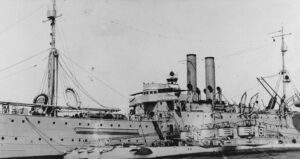 R8 was laid down on 4 March 1918, launched 17 April 1919, completed on 21 July 1919. Fitted out Boston fall 1919, HP New London 5 December, SubDiv 9, winter exercises, Pensacola, then back to New England April 1920. “SS-85” July, Newport 13 September for Norfolk, overhaul, then transferred Pacific Fleet, San Pedro, 30 June. 16 July 1923 sailed for Pearl Harbor. Late October 1925, she collided with minesweeper USS Widgeon (AM-22), periscopes torn off, bridge mushed, radio antenna supports gone. Repaired. August 1927, searched for missing Dole Air Race aviators.
R8 was laid down on 4 March 1918, launched 17 April 1919, completed on 21 July 1919. Fitted out Boston fall 1919, HP New London 5 December, SubDiv 9, winter exercises, Pensacola, then back to New England April 1920. “SS-85” July, Newport 13 September for Norfolk, overhaul, then transferred Pacific Fleet, San Pedro, 30 June. 16 July 1923 sailed for Pearl Harbor. Late October 1925, she collided with minesweeper USS Widgeon (AM-22), periscopes torn off, bridge mushed, radio antenna supports gone. Repaired. August 1927, searched for missing Dole Air Race aviators.
Back East Coast for inactivation 1930, Philadelphia, 9 February 1931. Decommissioned 2 May 1931, berthed in Reserve Fleet until 1936. 26 February 1936, she sank. Later raised, stricken on 12 May 1936. 19 August used as a target for aerial bombing test. Sunk by four near-misses with 100 lb (45 kg) bombs off Cape Henry in Virginia. Wreck rediscovered by December 2020 off Ocean City, Maryland.
 R9 (1919)
R9 (1919)
 R-9 laid down on 6 March 1918 at Fore River, launched 24 May 1919, commissioned on 30 July 1919. SS-86 in July 1920, operated on northeast coast with SubDiv 9 until 1924. Pacific in March, Pearl Harbor HP from 4 May. 12 December 1930 ordered back to the Atlantic, Philadelphia for inactivation 9 February, decommissioned 2 May 1931, Reserve Fleet.
R-9 laid down on 6 March 1918 at Fore River, launched 24 May 1919, commissioned on 30 July 1919. SS-86 in July 1920, operated on northeast coast with SubDiv 9 until 1924. Pacific in March, Pearl Harbor HP from 4 May. 12 December 1930 ordered back to the Atlantic, Philadelphia for inactivation 9 February, decommissioned 2 May 1931, Reserve Fleet.
Reiced com. September 1940, reactivated in New London where until full commission 14 March 1941. Trained in Caribbean Sea, Coco Solo on 27 May, patrolled approaches with SubRon 3 until October. Then Overhauled at New London from 23 May. By December 1941 Submarine School. Jan 1942 sailed to Casco Bay then rotated between New London and Bermuda with shipping lanes and Bermuda Patrol Areas. Started rotations with ASW training programs from spring of 1943, New London area. March 1945 trained with escort carriers off Cuba, Florida. Mid-May back to New London, 20 September to Portsmouth, decommissioned on 25 September 1945, stricken 11 October, scrapped February 1946.
 R10 (1919)
R10 (1919)
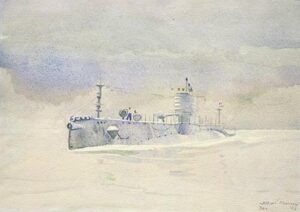 R-10 was laid down on 21 March 1918 at Fore River, launched 28 June 1919, commissioned on 20 August 1919. Left Boston, fall 1919, for SubDiv 9, winter maneuvers from 15 January 1920. HP Pensacola, then back to New England, Newport, in May, SS-87 in July, and overhaul until April 1921. Reassigned Pacific, San Pedro. She had a salvage operation with USS Cardinal (AM-6) to raise R-6 (SS-83) in San Pedro Harbor, 13 October 1921. July 1923, sent to Pearl Harbor and lmade an endurance run to Midway Island to the West Coast, air-sea rescue. Back to the Atlantic in 1930, New London, TS for Submarine School. Overhaul at Portsmouth, ASW destroyer TS, NROTC cruises between New england and mid-Atlantic seaboard, TS Piney Point in May 1937. She was not placed in reserve. By September 1940, took part in Bureau of Ordnance tests at Norfolk. Transferred to Key West and from 1941 to the winter of 1943, patrols in Yucatán Channel, Florida Straits and TS Fleet Sonar School, Key West. Then until 1945, TS at full time notably off Port Everglades and Key West until 4 June. Sent to Philadelphia for inactivation 8 June, decommissioned 18tj, stricken 11 July, sold for BU January 1946.
R-10 was laid down on 21 March 1918 at Fore River, launched 28 June 1919, commissioned on 20 August 1919. Left Boston, fall 1919, for SubDiv 9, winter maneuvers from 15 January 1920. HP Pensacola, then back to New England, Newport, in May, SS-87 in July, and overhaul until April 1921. Reassigned Pacific, San Pedro. She had a salvage operation with USS Cardinal (AM-6) to raise R-6 (SS-83) in San Pedro Harbor, 13 October 1921. July 1923, sent to Pearl Harbor and lmade an endurance run to Midway Island to the West Coast, air-sea rescue. Back to the Atlantic in 1930, New London, TS for Submarine School. Overhaul at Portsmouth, ASW destroyer TS, NROTC cruises between New england and mid-Atlantic seaboard, TS Piney Point in May 1937. She was not placed in reserve. By September 1940, took part in Bureau of Ordnance tests at Norfolk. Transferred to Key West and from 1941 to the winter of 1943, patrols in Yucatán Channel, Florida Straits and TS Fleet Sonar School, Key West. Then until 1945, TS at full time notably off Port Everglades and Key West until 4 June. Sent to Philadelphia for inactivation 8 June, decommissioned 18tj, stricken 11 July, sold for BU January 1946.
 R11 (1919)
R11 (1919)
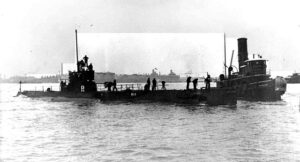 R-11 laid down at Fore River March 18, 1918, launched March 21, 1919, commissioned September 5, 1919. Inactive at Boston with skeleton crew after commissioning. In 1920 had a full crew and commenced trainin off New England and from April, Bermuda. HP New London, then sailed May 31 for the Pacific. As SS-88 in July, Pearl Harbor August 4, HP for 10 years. Departed December 12, 1930 for San Diego, then New London on February 9, 1931, used for 10 years as TS, Submarine School and for NROTC units. Transferred to Key West by June 1, 1941, patrols and TS until decommissioned on September 5, 1945, stricken October 11, sold March 13, 1946, BU 1948.
R-11 laid down at Fore River March 18, 1918, launched March 21, 1919, commissioned September 5, 1919. Inactive at Boston with skeleton crew after commissioning. In 1920 had a full crew and commenced trainin off New England and from April, Bermuda. HP New London, then sailed May 31 for the Pacific. As SS-88 in July, Pearl Harbor August 4, HP for 10 years. Departed December 12, 1930 for San Diego, then New London on February 9, 1931, used for 10 years as TS, Submarine School and for NROTC units. Transferred to Key West by June 1, 1941, patrols and TS until decommissioned on September 5, 1945, stricken October 11, sold March 13, 1946, BU 1948.
 R12 (1919)
R12 (1919)
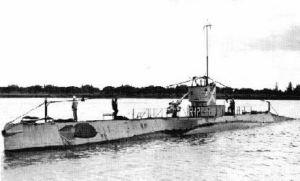 R-12 laid down at Fore River on 28 March 1918, launched 15 August 1919, commissioned at Boston 23 September 1919. departed 11 March to New London, went to Panama, transited to San Pedro in July as “SS-89”, then Pearl Harbor, 6 September 1920, remained until 1930. 10 May 1921 she ran out of fuel, lost radio com. while searching for ocean going tug USS Conestoga from Mare Island. Batteries flooded, lost all power. She departed 12 December 1930, back to New London 9 February 1931. Traied with Destroyer Squadrons, Scouting Force, then overhaul and TS at Submarine School. 27 September 1932, departed New London for Philadelphia, decom. 7 December, Reserve Fleet. Reactivated from 1 July 1940, recom. 16 October, Panama on 10 December and patolled approaches from October 1941, bac to HP New London on 31 October. February 1942, patrols from Guantanamo Bay and Key West and March-April 1943 back at New London, then Key West in May, TS. On 12 June 1943 while underway for torpedo practice approach, she sounded her last diving alarm but when prepared to dive, her forward battery compartment was flooded. Orders to blow main ballast, but nor fast enough. She filled in 15 seconds, sank to the bottom. Lieutenant Commander Edward E. Shelby, another officer, and 3 enlisted men escaped from the bridge, later rescued after 6 hours by USS SC-449. 52 went down with R12 and she was stricken on 6 July. Her wreck was rediscovered on 25 May 2011 by Tim Taylor on RV Tiburon. Reason of loss remains unknown.
R-12 laid down at Fore River on 28 March 1918, launched 15 August 1919, commissioned at Boston 23 September 1919. departed 11 March to New London, went to Panama, transited to San Pedro in July as “SS-89”, then Pearl Harbor, 6 September 1920, remained until 1930. 10 May 1921 she ran out of fuel, lost radio com. while searching for ocean going tug USS Conestoga from Mare Island. Batteries flooded, lost all power. She departed 12 December 1930, back to New London 9 February 1931. Traied with Destroyer Squadrons, Scouting Force, then overhaul and TS at Submarine School. 27 September 1932, departed New London for Philadelphia, decom. 7 December, Reserve Fleet. Reactivated from 1 July 1940, recom. 16 October, Panama on 10 December and patolled approaches from October 1941, bac to HP New London on 31 October. February 1942, patrols from Guantanamo Bay and Key West and March-April 1943 back at New London, then Key West in May, TS. On 12 June 1943 while underway for torpedo practice approach, she sounded her last diving alarm but when prepared to dive, her forward battery compartment was flooded. Orders to blow main ballast, but nor fast enough. She filled in 15 seconds, sank to the bottom. Lieutenant Commander Edward E. Shelby, another officer, and 3 enlisted men escaped from the bridge, later rescued after 6 hours by USS SC-449. 52 went down with R12 and she was stricken on 6 July. Her wreck was rediscovered on 25 May 2011 by Tim Taylor on RV Tiburon. Reason of loss remains unknown.
 R13 (1919)
R13 (1919)
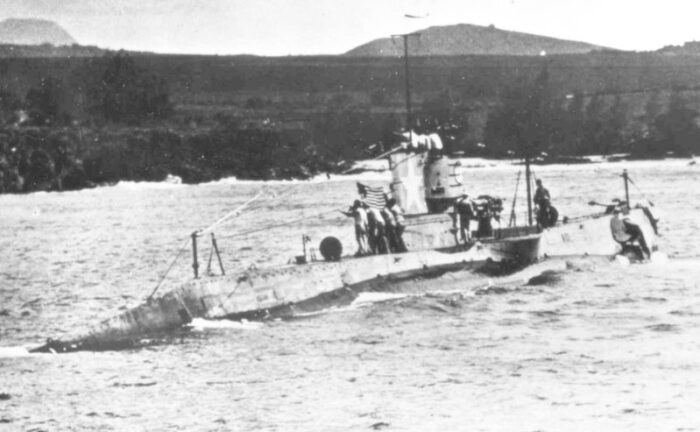
USS R13 in Panama Canal area, early 1920s. Note the large white star painted on her CT.
R-13 laid down at Fore River 27 March 1918, launched 27 August 1919, commissioned 17 October 1919. Operated out of New London then TS patrol spring 1920 off Bermuda, transferred Pacific mid-June, SS-90 when arriving at San Pedro, then Hawaii 6 September. Back Atlantic on 9 February 1931, HP New London. TS until 1941. On 26 May 1941, reassigned HP Key West, alternated with New London. Gulf of Mexico patirls and TS, Sound School, Key West. Decommissioned on 14 September 1945, stricken 11 October 1945, sold 13 March 1946.
 R14 (1919)
R14 (1919)
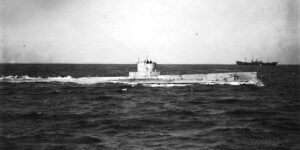 R-14 laid down at Fore River 6 November 1918, launched on 10 October 1919, commissioned 24 December 1919. Shakedown cruise New England, HP New London, transferred Pacific Fleet, renamed SS-91 and arrived at Pearl Harbor via San Predo, 6 September 1920. Under Lt. Alexander Dean Douglas she ran out of usable fuel after seawater contamination, lost radio com. in May 1921 while in surface search mission for missing tug Conestoga off Hawaii. Lost all power. A makeshift sail made of eight hammocks hung from the top boom made with pipe bunk frames lashedtogether placed on her vertical kingpost of the torpedo loading crane forward allowed her to cruise back to Hawaii at 1 knot, also steered by a mainsail made of six blankets on the radio mast for 0.5 knots more and a mizzen sail made of eight blankets from the other top boom made of bunk frames for another 0.5 knots, 2 knots total. She manage to had her batteries reloaded by dragging propellers on 12 May 1921 through the water under sail, turning back the shafts. Various problems were solved and she managed to reach Hilo after 64 hours under sail, entering port on battery power and sail on 15 May 1921. Douglas received a letter of commendation by Chester W. Nimitz, USN. On 12 December 1930, departed Pearl Harbor for the Atlantic via San Diego, Panama to New London on 9 February 1931. TS for the Submarine School until spring 1941, East Coast, Key West HP from 1 June. Fall 1941, New London overhaul. 22 November back Key West. Until April 1945, alsternated TS at Sound School and Yucatán Channel-Florida Straits patrols. 29 June 1943 she was fired at by the US Army Coast Artillery Corps guns at Fort Zachary Taylor, mistook for an U-boat while off Key West, no damage. Arrived by May 1945 at Philadelphia, decommissioned on 7 May, stricken 19th sold 28 September, scrapped 1946.
R-14 laid down at Fore River 6 November 1918, launched on 10 October 1919, commissioned 24 December 1919. Shakedown cruise New England, HP New London, transferred Pacific Fleet, renamed SS-91 and arrived at Pearl Harbor via San Predo, 6 September 1920. Under Lt. Alexander Dean Douglas she ran out of usable fuel after seawater contamination, lost radio com. in May 1921 while in surface search mission for missing tug Conestoga off Hawaii. Lost all power. A makeshift sail made of eight hammocks hung from the top boom made with pipe bunk frames lashedtogether placed on her vertical kingpost of the torpedo loading crane forward allowed her to cruise back to Hawaii at 1 knot, also steered by a mainsail made of six blankets on the radio mast for 0.5 knots more and a mizzen sail made of eight blankets from the other top boom made of bunk frames for another 0.5 knots, 2 knots total. She manage to had her batteries reloaded by dragging propellers on 12 May 1921 through the water under sail, turning back the shafts. Various problems were solved and she managed to reach Hilo after 64 hours under sail, entering port on battery power and sail on 15 May 1921. Douglas received a letter of commendation by Chester W. Nimitz, USN. On 12 December 1930, departed Pearl Harbor for the Atlantic via San Diego, Panama to New London on 9 February 1931. TS for the Submarine School until spring 1941, East Coast, Key West HP from 1 June. Fall 1941, New London overhaul. 22 November back Key West. Until April 1945, alsternated TS at Sound School and Yucatán Channel-Florida Straits patrols. 29 June 1943 she was fired at by the US Army Coast Artillery Corps guns at Fort Zachary Taylor, mistook for an U-boat while off Key West, no damage. Arrived by May 1945 at Philadelphia, decommissioned on 7 May, stricken 19th sold 28 September, scrapped 1946.
 R15 (1917)
R15 (1917)
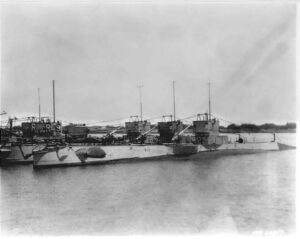 R-15 was was laid down at the Union Iron Works in San Francisco, California, on 30 April 1917, launched on 12 October 1917, commissioned on 27 July 1918. She became the lead boat of her class and one of the rare subs actually seeing “service” in WWI. After shakedown, she served off the Panama Canal Zone, HP Balboa until December 1918, then assigned to California by January 1919, San Pedro, San Diego, and had an overhaul at Mare Island Naval before transfer to Pearl Harbor on 25 June, and SS-92 in July 1920. On 12 December 1930 she sailed for the East Coast and inactivation, decommissioned at Philadelphia on 7 May 1931, Reserve Fleet reactivated, summer 1940, Thames River on 9 September, recommissioned fully on 1 April, patrolled the Canal Zone with SubRon 3. 3 October sent to New London, SubRon 7. Patrolled off the east coast. February 1942 patrolled in the Virgin Islands area, then TS in Trinidad. Relieved in August, Virgin Islands and Bermuda patrols and refit in New London. Next patrolled in Guantanamo Bay, Virgin Islands; Bermuda and by April 1944, New London. Back to Bermuda area 14 December 1944 and until summer 1945, operated off the Florida coast and until 17 June 1945, Guantanamo Bay. 2 September saw her in Key West. She was decommissioned on 17 September, stricken 11 October, sold for BU.
R-15 was was laid down at the Union Iron Works in San Francisco, California, on 30 April 1917, launched on 12 October 1917, commissioned on 27 July 1918. She became the lead boat of her class and one of the rare subs actually seeing “service” in WWI. After shakedown, she served off the Panama Canal Zone, HP Balboa until December 1918, then assigned to California by January 1919, San Pedro, San Diego, and had an overhaul at Mare Island Naval before transfer to Pearl Harbor on 25 June, and SS-92 in July 1920. On 12 December 1930 she sailed for the East Coast and inactivation, decommissioned at Philadelphia on 7 May 1931, Reserve Fleet reactivated, summer 1940, Thames River on 9 September, recommissioned fully on 1 April, patrolled the Canal Zone with SubRon 3. 3 October sent to New London, SubRon 7. Patrolled off the east coast. February 1942 patrolled in the Virgin Islands area, then TS in Trinidad. Relieved in August, Virgin Islands and Bermuda patrols and refit in New London. Next patrolled in Guantanamo Bay, Virgin Islands; Bermuda and by April 1944, New London. Back to Bermuda area 14 December 1944 and until summer 1945, operated off the Florida coast and until 17 June 1945, Guantanamo Bay. 2 September saw her in Key West. She was decommissioned on 17 September, stricken 11 October, sold for BU.
 R16 (1917)
R16 (1917)
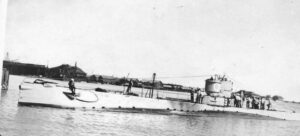 R-16 was laid down at Union Iron Works (UIW) on 26 April 1917, launched on 15 December 1917, commissioned on 5 August 1918. She trained of Balboa, Panama and patrolled until December 1918. Then West Coast until June 1919. 17 June she left San Francisco for Pearl Harbor as SS-93, stayed there for 11 years. Departed for home on 12 December 1930, reached and placed 12 May 1931 in reserve for nine years. Recom. partially 1 July 1940, reactivated, then patrolled off Panama. Fall 1941 Key West. 18 December New London HP for patrols ad ASW training until February 1942. Virgin Islands in March 1942, patrolled also off St. Thomas and Trinidad. 7 December 1942 she was mistook for U-Boat and fired at by Army transport USAT Florida. She submerged and avoided damage.
R-16 was laid down at Union Iron Works (UIW) on 26 April 1917, launched on 15 December 1917, commissioned on 5 August 1918. She trained of Balboa, Panama and patrolled until December 1918. Then West Coast until June 1919. 17 June she left San Francisco for Pearl Harbor as SS-93, stayed there for 11 years. Departed for home on 12 December 1930, reached and placed 12 May 1931 in reserve for nine years. Recom. partially 1 July 1940, reactivated, then patrolled off Panama. Fall 1941 Key West. 18 December New London HP for patrols ad ASW training until February 1942. Virgin Islands in March 1942, patrolled also off St. Thomas and Trinidad. 7 December 1942 she was mistook for U-Boat and fired at by Army transport USAT Florida. She submerged and avoided damage.
By 1 March 1943, HP New London, submarine school, sound laboratory, destroyer training. From 1 August 1943 to 20 March 1944, patrolled off Bermuda and R&R in New London 1945.
Sailed to Philadelphia on 4 July 1945, decommissioned 16 July, stricken 25 July, sold March 1946.
 R17 (1917)
R17 (1917)
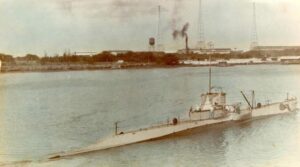 R-17 laid down at UIW 5 May 1917, launched 24 December 1917, commissioned 17 August 1918 under Lt. Commander William R. Munroe. Trained and patrolled off the California coast, Panama Canal Zone. By March 1919, overhaul started at San Francisco and sailed for Pearl Harbor, arrived 25 June, operated there as SS-94, recalled on 12 December 1930 for San Diego, then East Coast, Philadelphia, 9 February 1931, decommissioned 15 May, reserve at League Island, recommissioned at New London on 25 March 1941. In May-June patrolled the Virgin Islands, Canal Zone in July-September and back to New London, used as TS. 9 March 1942 decommissioned, transferred to UK under lend-lease as HMS P.512, stayed in Bermuda as TS for the RCN until 6 September 1944, returned to the USN, used at target ship in September, struck 22 June 1945, sold 16 November 1945.
R-17 laid down at UIW 5 May 1917, launched 24 December 1917, commissioned 17 August 1918 under Lt. Commander William R. Munroe. Trained and patrolled off the California coast, Panama Canal Zone. By March 1919, overhaul started at San Francisco and sailed for Pearl Harbor, arrived 25 June, operated there as SS-94, recalled on 12 December 1930 for San Diego, then East Coast, Philadelphia, 9 February 1931, decommissioned 15 May, reserve at League Island, recommissioned at New London on 25 March 1941. In May-June patrolled the Virgin Islands, Canal Zone in July-September and back to New London, used as TS. 9 March 1942 decommissioned, transferred to UK under lend-lease as HMS P.512, stayed in Bermuda as TS for the RCN until 6 September 1944, returned to the USN, used at target ship in September, struck 22 June 1945, sold 16 November 1945.
 R18 (1918)
R18 (1918)
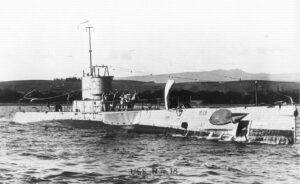 R-18 was laid down on 16 June 1917 at UIW, launched 8 January 1918, commissioned 11 September 1918. After shakedown, assigned to the Panama Canal Zone. San Pedro from January to March 1919, overhaul San Francisco, sent to Hawaii 25 June as SS-95. Sailed back home on 12 December 1930, via San Pedro, Panama, East Coast and inactivation in Philadelphia, decom. 13 May 1931, berthed at League Island. Reactivated from 8 January 1941, New London until May. 12 May sailed to Panama Canal Zone, patrolled until September 1941. October New London for overhaul, ASW TS. January 1942sent to Casco Bay, patrolled from Nantucket Light to Bermud from New London, then Bermuda by May 1942. 30 May was mistook for an U Boat by a U.S. Navy OS2U-2 Kingfisher, crash-dived 50 nm off Bermuda′s Mount Hill Lighthouse. No damage. August 1942 patrolled off Virgin Islands and Trinidad. The TS until May 1945 from New London, also Portland in June 1943. Bermuda July-December 1943. January-March 1944 New England. April 1944 Key West, Port Everglades. 1945 New London. Last trip to Florida and back and in September 1945, New Hampshire for inactivatio at Portsmouth 7 September 1945, decom. 19 September 1945, stricken October 1945, sold 1946.
R-18 was laid down on 16 June 1917 at UIW, launched 8 January 1918, commissioned 11 September 1918. After shakedown, assigned to the Panama Canal Zone. San Pedro from January to March 1919, overhaul San Francisco, sent to Hawaii 25 June as SS-95. Sailed back home on 12 December 1930, via San Pedro, Panama, East Coast and inactivation in Philadelphia, decom. 13 May 1931, berthed at League Island. Reactivated from 8 January 1941, New London until May. 12 May sailed to Panama Canal Zone, patrolled until September 1941. October New London for overhaul, ASW TS. January 1942sent to Casco Bay, patrolled from Nantucket Light to Bermud from New London, then Bermuda by May 1942. 30 May was mistook for an U Boat by a U.S. Navy OS2U-2 Kingfisher, crash-dived 50 nm off Bermuda′s Mount Hill Lighthouse. No damage. August 1942 patrolled off Virgin Islands and Trinidad. The TS until May 1945 from New London, also Portland in June 1943. Bermuda July-December 1943. January-March 1944 New England. April 1944 Key West, Port Everglades. 1945 New London. Last trip to Florida and back and in September 1945, New Hampshire for inactivatio at Portsmouth 7 September 1945, decom. 19 September 1945, stricken October 1945, sold 1946.
 R19 (1918)
R19 (1918)
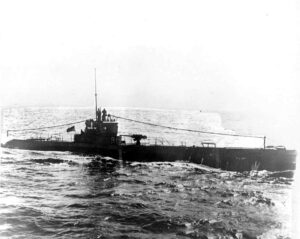 R-19 was laid down by UIW on 23 June 1917, launched 28 January 1918, commissioned on 7 October 1918. One month before the Armistice she stayed training on the West Coast for 9 months at San Pedro Submarine Base until March 1919, San Francisco for overhaul until June 1919. 17 June she sailed for Hawaii, stayed at Pearl Harbor for 12 years. July 1920 she was SS-96. 12 December 1930 sailed for inactivation at Philadelphia via San Diego, Panama, decom. 15 May 1931, reserve fleet. Recommissioned on 6 January 1941, New London, Groton to be reconditioned. May 1941, patrolled and trained in the Virgin Islands and Panama Canal Zone. October 1941, Groton for overhaul and TS. Decom. 9 March 1942, transferred to RN under Lend-Lease on 9 March 1942 as HMS P.514. Served from Newfoundland under Lt. Walter Phillimore when at 0300 on 21 June 1942 while surfaced she was fired at by HMCS Georgian off Newfoundland, and finally rammed. She sank with all hands, mistook for an U-Boat. The Board of Inquiry did no blamed the commanding officer.
R-19 was laid down by UIW on 23 June 1917, launched 28 January 1918, commissioned on 7 October 1918. One month before the Armistice she stayed training on the West Coast for 9 months at San Pedro Submarine Base until March 1919, San Francisco for overhaul until June 1919. 17 June she sailed for Hawaii, stayed at Pearl Harbor for 12 years. July 1920 she was SS-96. 12 December 1930 sailed for inactivation at Philadelphia via San Diego, Panama, decom. 15 May 1931, reserve fleet. Recommissioned on 6 January 1941, New London, Groton to be reconditioned. May 1941, patrolled and trained in the Virgin Islands and Panama Canal Zone. October 1941, Groton for overhaul and TS. Decom. 9 March 1942, transferred to RN under Lend-Lease on 9 March 1942 as HMS P.514. Served from Newfoundland under Lt. Walter Phillimore when at 0300 on 21 June 1942 while surfaced she was fired at by HMCS Georgian off Newfoundland, and finally rammed. She sank with all hands, mistook for an U-Boat. The Board of Inquiry did no blamed the commanding officer.
 R20 (1918)
R20 (1918)
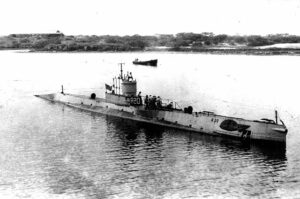 R-20 was laid down on 4 June 1917 at UIW, launched 21 January 1918, commissioned on 26 October 1918 under Lt. Cdr. Alfred E. Montgomery, fitted at San Pedro, and trained between San Pedro and San Diego until March 1919. Overhauled at San Francisco, departed 17 June for Hawaii, Pearl Harbor. As SS-97 she served there until recalled for the east coast on 12 December 1930, sailed for Philadelphia, decommissioned on 15 May, berthed at League Island. Reactivated on 22 January 1941, New London, TS and patroled until June. Next she was posted in Key West from 22 June as TS until May 1945. She was decommissioned at Key West on 27 September 1945, stricken in October, sold 13 March 1946.
R-20 was laid down on 4 June 1917 at UIW, launched 21 January 1918, commissioned on 26 October 1918 under Lt. Cdr. Alfred E. Montgomery, fitted at San Pedro, and trained between San Pedro and San Diego until March 1919. Overhauled at San Francisco, departed 17 June for Hawaii, Pearl Harbor. As SS-97 she served there until recalled for the east coast on 12 December 1930, sailed for Philadelphia, decommissioned on 15 May, berthed at League Island. Reactivated on 22 January 1941, New London, TS and patroled until June. Next she was posted in Key West from 22 June as TS until May 1945. She was decommissioned at Key West on 27 September 1945, stricken in October, sold 13 March 1946.
 R21 (1918)
R21 (1918)
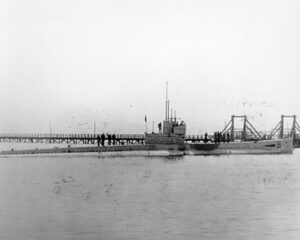 USS R-21 was laid down on 19 April 1917 at the Lake Torpedo Boat Company in Bridgeport, Connecticut, first of the last batch until R-27 to be discarded in 1930 and not participate in WW2. She was launched on 10 July 1918 and commissioned on 17 June 1919. SubDiv 1, New London, trained off Long Island Sound, shakedown off Block Island. Alternated between Torpedo Station Newport and New London. Departed 1 November 1919 with R-22, R-24, R-27, Eagle No. 31 via Hampton Roads and Savannah, Key West, Havana, Cienfuegos, and Guantanamo Bay, Kingston, to Coco Solo, Panama on 11 December.
USS R-21 was laid down on 19 April 1917 at the Lake Torpedo Boat Company in Bridgeport, Connecticut, first of the last batch until R-27 to be discarded in 1930 and not participate in WW2. She was launched on 10 July 1918 and commissioned on 17 June 1919. SubDiv 1, New London, trained off Long Island Sound, shakedown off Block Island. Alternated between Torpedo Station Newport and New London. Departed 1 November 1919 with R-22, R-24, R-27, Eagle No. 31 via Hampton Roads and Savannah, Key West, Havana, Cienfuegos, and Guantanamo Bay, Kingston, to Coco Solo, Panama on 11 December.
Crossed on 27 January 1920 for refit in drydock at Balboa, back to Coco Solo, trained and made 2 trips to Almirante Bay, 30 March-2 April and 17–20 May. SS-98 in July, sailed to Balboa 27 September, drydocked, back to Coco Solo, then 11 month overhaul. Left 26 September 1921 for Key West, then NyC and New London, 27 October, Portsmouth, refit from 27 December. Made her first dive on 26 May 1922, back to New London. October 1922 sent to Coco Solo, Division flagship but engine troubles, assisted by SS Bethore. Alternated between Coco Solo and repairs at Balboa. Last cruise on 15 February 1923 with tender, Quail (AM-15). Was towed after engines breakdown into Guantanamo, repaired, shen sailed for Philadelphia, arrived November 1923, Decommissioned 21 June 1924, stricken 9 May 1930, sold 30 July 1930.
 R22 (1918)
R22 (1918)
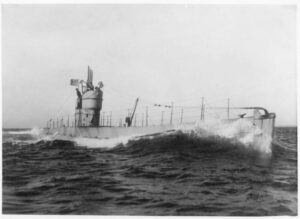 R-23 was laid down on 19 April 1917 at Lake, launched on 23 September 1918, commissioned on 1 August 1919. She operated with SunDiv 1 from New London, Connecticut-Newport (Rhode Island) area over two months then Coco Solo, Panama Canal as new homeport. Under SS-99 she stayed there until transferred back to New London and experimental SubDiv 0 in New London, makinga sortie for the 1923 Fleet Problem. The summer of 1922 saw her bow rebuilt at Portsmouth over reserve buoyancy and seawhorthiness, bu afterwards she was inactivated in 1924, towed to Philadelphia, decommissioned 29 April 1925, stricken 9 May 1930, sold for scrapping in July 1930.
R-23 was laid down on 19 April 1917 at Lake, launched on 23 September 1918, commissioned on 1 August 1919. She operated with SunDiv 1 from New London, Connecticut-Newport (Rhode Island) area over two months then Coco Solo, Panama Canal as new homeport. Under SS-99 she stayed there until transferred back to New London and experimental SubDiv 0 in New London, makinga sortie for the 1923 Fleet Problem. The summer of 1922 saw her bow rebuilt at Portsmouth over reserve buoyancy and seawhorthiness, bu afterwards she was inactivated in 1924, towed to Philadelphia, decommissioned 29 April 1925, stricken 9 May 1930, sold for scrapping in July 1930.
 R23 (1918)
R23 (1918)
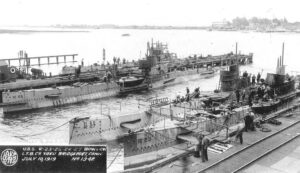 R-23 was laid down on 25 April 1917 at Lake, launched on 5 November 1918, commissioned on 23 October 1919. She trained at New London, then HP Coco Solo, Panama and as SS-100 in July 1920 ahs trained alternated with refits and overhaul at Balboa due to engine troubles. She was sent for inactivation fall 1924, to Philadelphia, decommissioned on 24 April 1925 (5.5 years of service…), berthed at League Island, stricken 9 May 1930, sold in July.
R-23 was laid down on 25 April 1917 at Lake, launched on 5 November 1918, commissioned on 23 October 1919. She trained at New London, then HP Coco Solo, Panama and as SS-100 in July 1920 ahs trained alternated with refits and overhaul at Balboa due to engine troubles. She was sent for inactivation fall 1924, to Philadelphia, decommissioned on 24 April 1925 (5.5 years of service…), berthed at League Island, stricken 9 May 1930, sold in July.
 R24 (1918)
R24 (1918)
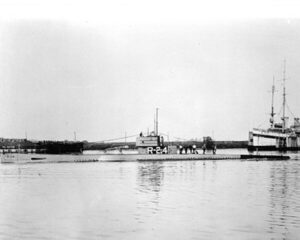 R-24 was laid down on 9 May 1919 at Lake, launched on 21 August 1918, commissioned on 27 June 1919. After New England training with SubDiv 1 she was sent to Coco Solo, later as SS-101. By the fall of 1921 she had a shipyard overhaul. Fall 1922, she operated off Coco Solo and Balboa. Had another shipyard overhaul and by the fall of 1924 was sent to Philly for inactivation, 25 January 1925, decommissioned, berthed at League Island until stricken on 9 May 1930, sold.
R-24 was laid down on 9 May 1919 at Lake, launched on 21 August 1918, commissioned on 27 June 1919. After New England training with SubDiv 1 she was sent to Coco Solo, later as SS-101. By the fall of 1921 she had a shipyard overhaul. Fall 1922, she operated off Coco Solo and Balboa. Had another shipyard overhaul and by the fall of 1924 was sent to Philly for inactivation, 25 January 1925, decommissioned, berthed at League Island until stricken on 9 May 1930, sold.
 R25 (1919)
R25 (1919)
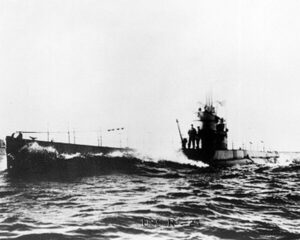 R-25 was laid down on 26 April 1917 at Lake, launched on 15 May 1919, commissioned on 23 October 1919 under Lt Cdr Charles A. Lockwood, Jr. and by November, she headed for Coco Solo. As SS-102 she alternated patorls and training there with overhauls between Balboa and the East Coast. November 1923 saw her sent to Philadelphia for inactivation overhaul, decom. 21 June 1924 (4.5 years service), laid up, stricken 9 May 1930, sold for BU.
R-25 was laid down on 26 April 1917 at Lake, launched on 15 May 1919, commissioned on 23 October 1919 under Lt Cdr Charles A. Lockwood, Jr. and by November, she headed for Coco Solo. As SS-102 she alternated patorls and training there with overhauls between Balboa and the East Coast. November 1923 saw her sent to Philadelphia for inactivation overhaul, decom. 21 June 1924 (4.5 years service), laid up, stricken 9 May 1930, sold for BU.
 R26 (1919)
R26 (1919)
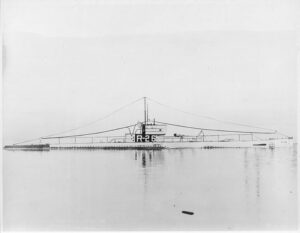 R-26 was laid down 26 April 1917 at Lake, launched on 18 June 1919, commissioned on 23 October 1919. She was homeported at Coco Solo from 26 November 1919, starting ops from 11 January 1920 as SS-103 with periodic overhauls at Balboa and East Coast, until inactivation in January 1925 and decom. Philadelphia on 12 June, League Island until struck by May 1930, sold in July.
R-26 was laid down 26 April 1917 at Lake, launched on 18 June 1919, commissioned on 23 October 1919. She was homeported at Coco Solo from 26 November 1919, starting ops from 11 January 1920 as SS-103 with periodic overhauls at Balboa and East Coast, until inactivation in January 1925 and decom. Philadelphia on 12 June, League Island until struck by May 1930, sold in July.
 R27 (1918)
R27 (1918)
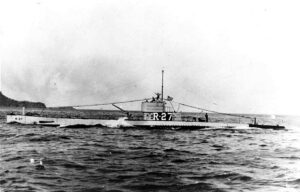 R-27 was laid down on 16 May 1917 at Lake, launched on 23 September 1918, commissioned on 3 September 1919, SubDiv 1, Coco Solo, Panama Canal Zone from December. Became SS-104 in July 1920, had an overhaul at Portsmouth (winter 1921-1922) and exeptionally made a run to Pearl Harbor for exercises in early 1923. On 1 November 1924 she left Coco Solo for Charleston (24 November) and towed to Philadelphia for decommission on 24 April 1925, berthed until struck on 9 May 1930, sold for scrap in July.
R-27 was laid down on 16 May 1917 at Lake, launched on 23 September 1918, commissioned on 3 September 1919, SubDiv 1, Coco Solo, Panama Canal Zone from December. Became SS-104 in July 1920, had an overhaul at Portsmouth (winter 1921-1922) and exeptionally made a run to Pearl Harbor for exercises in early 1923. On 1 November 1924 she left Coco Solo for Charleston (24 November) and towed to Philadelphia for decommission on 24 April 1925, berthed until struck on 9 May 1930, sold for scrap in July.
Read More/Src
Books
The Submarine Has No Friends: Friendly Fire Incidents Involving U.S subs Douglas E. Campbell, Charles R. Hinman
Blair, Clay (2000). Hitler’s U-Boat War: The Hunters 1939–1942. London: Cassell & Co.
Links
pigboats.com/ R-class
web.archive.org/ pigboats.com/subs/r-boats.html
history.navy.mil/ r-1.html
navweaps.com/ PreWWII torps
navweaps.com 3in-50
navypedia.org/ships/usa/us_ss_r.htm
United_States_R-class_submarine
Videos
Model Kits
None. Grigorovitch made 1:700 kits of the British R-class however.
on sdmodelmakers.com
otwdesigns.com made an RC version as well, at 1:32 scale


 Latest Facebook Entry -
Latest Facebook Entry -  X(Tweeter) Naval Encyclopedia's deck archive
X(Tweeter) Naval Encyclopedia's deck archive Instagram (@navalencyc)
Instagram (@navalencyc)





 French Navy
French Navy Royal Navy
Royal Navy Russian Navy
Russian Navy Armada Espanola
Armada Espanola Austrian Navy
Austrian Navy K.u.K. Kriegsmarine
K.u.K. Kriegsmarine Dansk Marine
Dansk Marine Nautiko Hellenon
Nautiko Hellenon Koninklije Marine 1870
Koninklije Marine 1870 Marinha do Brasil
Marinha do Brasil Osmanlı Donanması
Osmanlı Donanması Marina Do Peru
Marina Do Peru Marinha do Portugal
Marinha do Portugal Regia Marina 1870
Regia Marina 1870 Nihhon Kaigun 1870
Nihhon Kaigun 1870 Preußische Marine 1870
Preußische Marine 1870 Russkiy Flot 1870
Russkiy Flot 1870 Svenska marinen
Svenska marinen Søværnet
Søværnet Union Navy
Union Navy Confederate Navy
Confederate Navy Armada de Argentina
Armada de Argentina Imperial Chinese Navy
Imperial Chinese Navy Marinha do Portugal
Marinha do Portugal Mexico
Mexico Kaiserliche Marine
Kaiserliche Marine 1898 US Navy
1898 US Navy Sovietskiy Flot
Sovietskiy Flot Royal Canadian Navy
Royal Canadian Navy Royal Australian Navy
Royal Australian Navy RNZN Fleet
RNZN Fleet Chinese Navy 1937
Chinese Navy 1937 Kriegsmarine
Kriegsmarine Chilean Navy
Chilean Navy Danish Navy
Danish Navy Finnish Navy
Finnish Navy Hellenic Navy
Hellenic Navy Polish Navy
Polish Navy Romanian Navy
Romanian Navy Turkish Navy
Turkish Navy Royal Yugoslav Navy
Royal Yugoslav Navy Royal Thai Navy
Royal Thai Navy Minor Navies
Minor Navies Albania
Albania Austria
Austria Belgium
Belgium Columbia
Columbia Costa Rica
Costa Rica Cuba
Cuba Czechoslovakia
Czechoslovakia Dominican Republic
Dominican Republic Haiti
Haiti Hungary
Hungary Honduras
Honduras Estonia
Estonia Iceland
Iceland Eire
Eire Equador
Equador Iran
Iran Iraq
Iraq Latvia
Latvia Liberia
Liberia Lithuania
Lithuania Mandchukuo
Mandchukuo Morocco
Morocco Nicaragua
Nicaragua Persia
Persia San Salvador
San Salvador Sarawak
Sarawak Uruguay
Uruguay Venezuela
Venezuela Zanzibar
Zanzibar Warsaw Pact Navies
Warsaw Pact Navies Bulgaria
Bulgaria Hungary
Hungary

 Bundesmarine
Bundesmarine Dutch Navy
Dutch Navy Hellenic Navy
Hellenic Navy Marina Militare
Marina Militare Yugoslav Navy
Yugoslav Navy Chinese Navy
Chinese Navy Indian Navy
Indian Navy Indonesian Navy
Indonesian Navy JMSDF
JMSDF North Korean Navy
North Korean Navy Pakistani Navy
Pakistani Navy Philippines Navy
Philippines Navy ROKN
ROKN Rep. of Singapore Navy
Rep. of Singapore Navy Taiwanese Navy
Taiwanese Navy IDF Navy
IDF Navy Saudi Navy
Saudi Navy Royal New Zealand Navy
Royal New Zealand Navy Egyptian Navy
Egyptian Navy South African Navy
South African Navy






























 Ukrainian Navy
Ukrainian Navy dbodesign
dbodesign